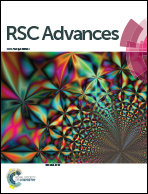Organoborane-containing polyacetylene derivatives: synthesis, characterization, and fluoride-sensing properties
Abstract
Triarylborane-containing polyacetylene derivatives (2a–c) were synthesized by the polymerization of the corresponding monomers with Rh+(nbd)[C6H5B−(C6H5)3] catalyst. The anion sensing ability of 2a–c was examined by using tetra-n-butylammonium salts of a series of halide ions. UV-vis absorption and emission measurements revealed that these polymers could selectively detect F−, while they did not show any response for Cl−, Br−, and I−. The fluoride sensing properties of these polymers are highly dependent on the structure of the spacers between the conjugated main chain and boron atoms. Namely, 2a containing fluorenyl moieties exhibited a “turn on” fluorescence F− sensing ability. 2b having phenyl spacers displayed emission quenching upon addition of F− in solution, and a signal amplification phenomenon was observed compared to the corresponding monomer. Addition of F− changed the color of the biphenyl group-containing 2c in THF from yellow to orange, indicating that 2c can be used as a colorimetric sensor.


 Please wait while we load your content...
Please wait while we load your content...